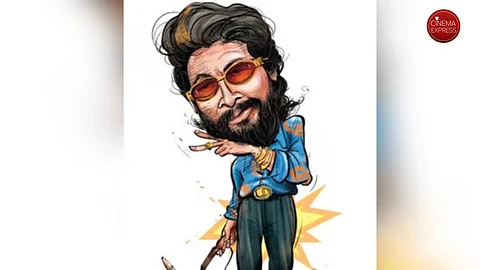

When the trailer of Allu Arjun’s Pushpa 2: The Rule was launched in Patna, Bihar, thousands thronged the event, eager to catch a glimpse of the star who embodies the almost-mythical protagonist of the franchise. For an audience often alienated by language barriers, Pushpa speaks a universal dialect of defiance and resilience. Bihar, a state known for its rampant worker migration, connects deeply with Pushpa's dishevelled hair, stained clothes, and beedi-smoking demeanour. He isn’t just a cinematic hero; he’s one of them—a labourer reflecting their struggles but with a dream of vengeance and dignity. His unyielding self-respect and fearless defiance become cathartic, a cinematic escape from their oppressive reality.
The overwhelming success of Pushpa in the northern belts lies in this inherent working-class ethos. When modern Hindi cinema heroes often emerge from urban spaces, suited up and armed with high-tech gadgets, Pushpa cuts a strikingly raw figure, holding nothing more than an axe. This spirit of rebellion and dignity recalls Amitabh Bachchan’s iconic working-class hero from Deewar (1975). In the first Pushpa, when his boss asks him to change his sitting posture, Pushpa quits the job, refusing even an extra note offered as a settlement. “This is enough for the work I have done,” he says, echoing Bachchan’s Vijay in Deewar: “Main aaj bhi phenke hue paise nahi uthata” (I refuse to accept money that is thrown at me). Like Vijay, Pushpa’s anthem—“Main Jhukega Nahi” (I will not bow)—captures his unrelenting quest for dignity. Self-respect, for Pushpa, is non-negotiable.
At its heart, Pushpa thrives on the underdog sentiment, coupled with Sukumar’s stylized visuals. Pushpa is a ‘local hero,’ his swagger embodied in his bent walk and the now-iconic gesture of brushing his beard. Allu Arjun, who fittingly won a National Award for his performance in the first film, is Pushpa incarnate in both films. This isn’t a performance aimed to play up stardom; this is simply the actor trusting that the character is bigger than him, trusting that the charms of Pushparaj will be enough to win national adulation. And it works. Pushpa’s violent retaliation against authority isn’t just about him; it’s an empowering release for audiences. In Pushpa 2: The Rule, Sukumar takes this to greater heights, presenting challenges that Pushpa conquers with rowdy flamboyance. And for that reason—and for the wave of support this character has garnered across the country—he is our newsmaker, this week.
Beneath the hyperactive exterior, the films are nuanced character studies of a broken man fighting back. While Pushpa’s alpha-male tendencies dominate his business dealings, his interactions with his mother and wife reveal a vulnerable core (captured in the song, ‘Sooseki’). His displeasure over the chief minister’s derogatory remarks about his wife, for instance, is handled with restraint, steering away from toxic masculinity. This duality—fearless on the outside, tender at home—grounds Pushpa and sets him apart from characters like Ranbir Kapoor’s Ranvijay in Animal, whose narcissism consumes everything around him. Pushpa, like Bachchan’s Vijay, is ultimately tethered by love—love for his family, his people, and his self-respect.
Sukumar explores this duality beautifully in the pre-interval exchange between Pushpa and Inspector Shekhawat, who had belittled Pushpa’s mother in the first film. As Pushpa contemplates whether to apologise, the moment transcends ego. It becomes a reflection of identity and dignity. His eventual refusal to say ‘sorry’ is not an entitled act but a reclamation of self-worth in a world that constantly ‘others’ the working class, in a world that may promote you and give you power but still constantly assert its superiority over you any chance it gets. Pushpa’s defiance forces those around him to confront their biases, making him a symbol of resistance against an unequal system.
This grounded ethos resonates deeply in the Hindi belts, offering reassurance that has been missing in mainstream Hindi cinema, which has shifted its focus to urban narratives. Pushpa hearkens back to the 80s and 90s, an era when working-class heroes dominated the silver screen. The response to both films in the northern belts is a testament to this nostalgia. There’s dialoguebaazi, heart-thumping action, melodrama, and song-and-dance—all the ingredients that once fueled single-screen theatres with rapturous energy. That these films are fronted by a Telugu superstar only underscores the universality of their appeal. There’s poetry in how these power dynamics transcend societies and languages, playing out in strikingly similar ways everywhere. It’s no wonder that what was ‘fire’ in the first film has become a ‘wildfire’ with the second.